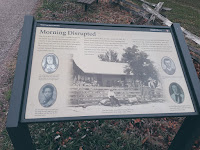 |
| Wilson's Creek battlefield from the Ray porch |
 |
| The Ray House (with porch) |
Sometimes the beauty of a national park site lies in perspective, in views that transport a visitor back to the time the park seeks to preserve.
That might be the saving grace of Wilson’s Creek National Battlefield, a little-known conflict early in the war and from the battles covered in history books.From the Ray’s front porch, one could watch the Battle of Wilson’s Creek unfold. Confederate soldiers emerged from the cornfield down the hill from the house, and the battle came to the Rays.
The family and their slaves would not watch the battle from the porch. They would retreat to the cellar and hide until hostilities on their land ended, apparently a common tactic among noncombatants stuck on Civil War battlefields.
The Ray House still stands, as does its springhouse downhill from the residence. The springhouse proved critical for providing water to the wounded and giving Confederate surgeons a place to clean their instruments.
Wilson’s Creek came before Pea Ridge, with the Union’s attempt to shut down Confederate activity in Missouri running into stiff resistance.
The second major conflict of the Civil War and the first west of the Mississippi, Wilson’s Creek resulted in Union forces pulling back, the first death of a Union general, and boosted the Confederacy in Arkansas and Missouri.
Most of the players are the same as Pea Ridge, but this battle unfolded in favor of the Confederates. Wilson’s Creek set off almost three years of battles for control of Missouri, with dozens of skirmishes and battles before Confederate troops had to pull back.
The terrain did not feel drastically different from 150 years earlier. Aside from the cornfields that hid some of the troops, the little stands of trees and the coursing creek harkened back to the 1860s. A five-mile loop circles the battlefield, ranging from its hilltop farms down to Wilson’s Creek and its branches cutting through the bottomlands.The land’s rolling topography provided more places for soldiers to hide, and control of the high ground seemed to give the artillery greater control. The wide-open spaces were not as wide here.
Only one top leader fell at Wilson’s Creek, the first from the Union Army. The Union commander, Gen. Nathaniel Lyon, had his horse shot from under him, then later sustained a fatal wound. His body was carried to a doctor by Confederates, in an unusual show of battlefield grace in a war where the losing side’s dead often ended up in unmarked mass graves.
Barely 90 minutes after Lyon’s death, Major Samuel Sturgis initiated the federal army’s withdrawal. Both sides claimed some level of victory, but it’s hard not to see Wilson’s Creek as a win for the Confederates, since Union efforts failed to expel them from Missouri.
I should have started the Missouri campaign with Wilson’s Creek, but the battlefield still offers a wealth of insights into the Civil War’s western frontier.




No comments:
Post a Comment